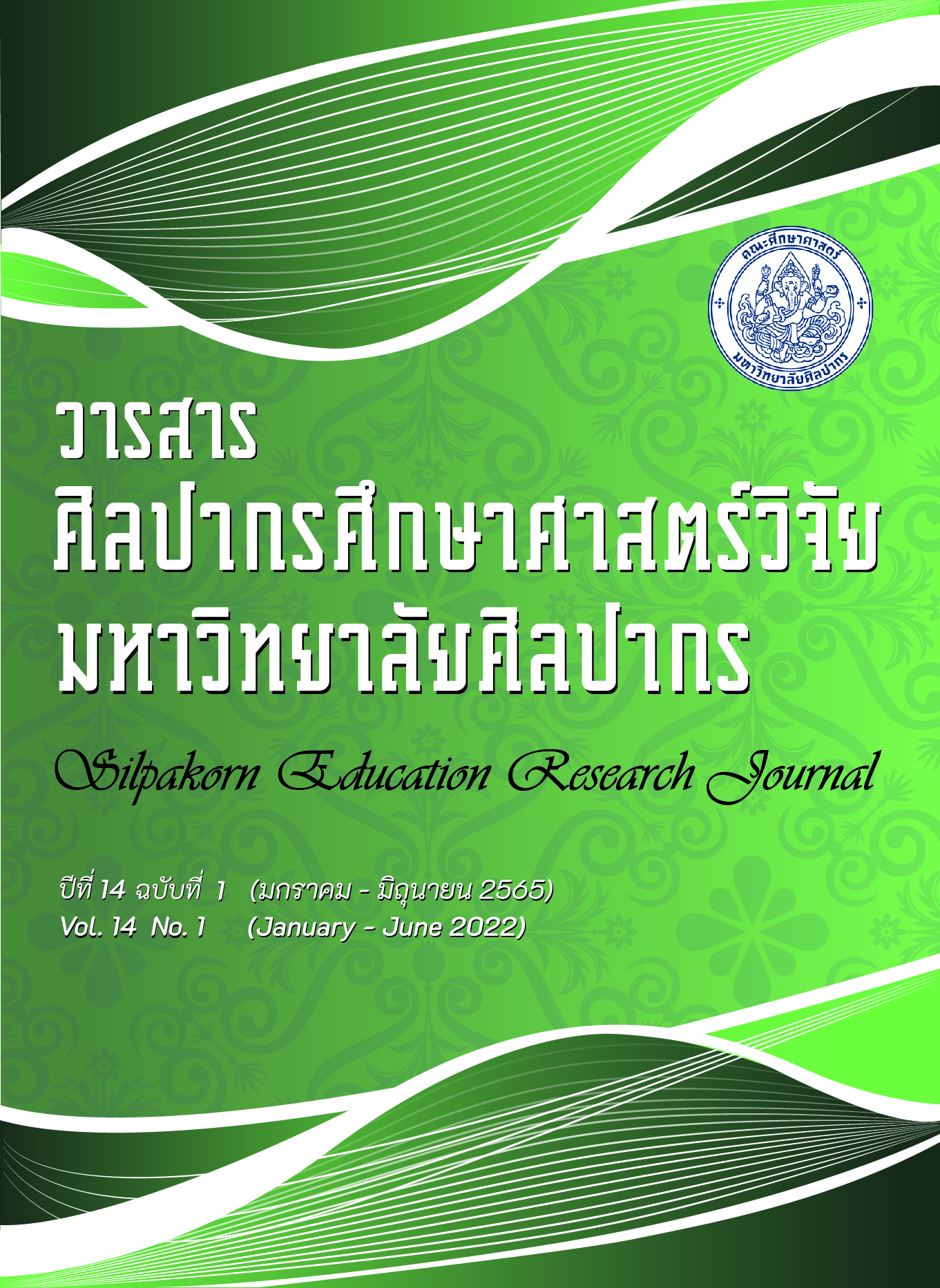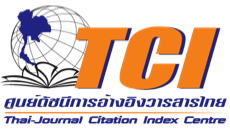การพัฒนาแบบวัดความรู้สึกเชิงจำนวน สำหรับนักเรียนชั้นประถมศึกษาปีที่ 6
คำสำคัญ:
การพัฒนาแบบวัด, ความรู้สึกเชิงจำนวนบทคัดย่อ
การวิจัยในครั้งนี้มีวัตถุประสงค์เพื่อ 1) สร้างและวิเคราะห์คุณภาพแบบวัดความรู้สึกเชิงจำนวนสำหรับนักเรียนชั้นประถมศึกษาปีที่ 6 และ 2) หาเกณฑ์ปกติ (Norms) ของแบบวัดความรู้สึกเชิงจำนวนสำหรับนักเรียนชั้นประถมศึกษาปีที่ 6 ที่สร้างขึ้น กลุ่มตัวอย่างในการศึกษาครั้งนี้ คือ นักเรียนชั้นประถมศึกษาปีที่ 6 จำนวน 786 คน จากโรงเรียนในสังกัดสำนักงานคณะกรรมการการศึกษาขั้นพื้นฐาน จังหวัดนครปฐม ภาคเรียนที่ 2 ปีการศึกษา 2563 ที่ได้มาจากการสุ่มแบบสองขั้นตอน เครื่องมือที่ใช้ในการวิจัยครั้งนี้เป็นแบบวัดความรู้สึกเชิงจำนวนแบบเลือกตอบ 4 ตัวเลือก จำนวน 24 ข้อ ประกอบด้วย 6 องค์ประกอบ ได้แก่ 1) ด้านความหมายของจำนวน 2) ด้านความสัมพันธ์ที่หลากหลายของจำนวน 3) ด้านการเปรียบเทียบจำนวน 4) ด้านผลการดำเนินการ และการประมาณค่า 5) ด้านการอ้างอิงในเรื่องปริมาณ และการวัด และ 6) ด้านการคิดคำนวณในใจได้อย่างยืดหยุ่น วิเคราะห์ข้อมูลด้วย ความตรงเชิงเนื้อหา ค่าความยาก ค่าอำนาจจำแนก ค่าความเที่ยงวิเคราะห์โดยใช้สูตร KR20 และหาเกณฑ์ปกติในรูปของคะแนนมาตรฐานทีปกติ
ผลการวิจัยพบว่า 1) แบบวัดความรู้สึกเชิงจำนวนสำหรับนักเรียนชั้นประถมศึกษาปีที่ 6 ความตรงเชิงเนื้อหามีความสอดคล้องอยู่ระหว่าง 0.60 – 1.00 การทดลองใช้ครั้งที่ 1 มีค่าความยากอยู่ที่ 0.21 ถึง 1.00 มีค่าอำนาจจำแนกอยู่ที่ - 0.17 ถึง 0.71 การทดลองใช้ครั้งที่ 2 มีค่าความยากอยู่ที่ 0.05 ถึง 0.65 มีค่าอำนาจจำแนกอยู่ที่ -0.11 ถึง 0.68 คัดเลือกแบบวัดให้เหลือ 24 ข้อ มีค่าความยากอยู่ที่ 0.20 ถึง 0.65 มีค่าอำนาจจำแนกอยู่ที่ 0.26 ถึง 0.84 มีค่าความเที่ยงเท่ากับ 0.80 เมื่อนำแบบวัดไปใช้จริงมีค่าความยากอยู่ระหว่าง 0.27 - 0.60 ค่าอำนาจจำแนกอยู่ระหว่าง 0.22 - 0.67 และค่าความเที่ยงทั้งฉบับเท่ากับ 0.77 2) แบบวัดความรู้สึกเชิงจำนวน
เอกสารอ้างอิง
Burns and Grove. (1997). The Practice of Nursing Research : Conduct Critique and
Fongsri P. (2014). Construction and development for research tool. 4thed. Bangkok: Dansutra Printing.
Howden. (1989). “Teacher Number Sense.” Arithmetic Teacher, 36(6):6-11. February.
Kanjanawasee S. (2013). Modern test theory. 6thed. Bangkok: Chulalongkorn University.
Leeyavanich R. Math teacher guide Teaching math with games. 1sted. Bangkok: Chulalongkorn University.
McIntosh and Reys and Reys. (1992). “A proposed framework for examining basic number sense.” The learning of mathematics, 12(3), 2-8
Maghfirah and Mahmudi. (2018). “Number sense: the result of mathematical experience.” Journal of Physics.
Makanong A. (2014). Mathematics for secondary school teachers. 2nded. Bangkok : Chulalongkorn University.
Mokkarat S. (2012). The Study of Capailities on Number Sense of Pratomsuksa 6 students. Master of Education Thesis Program in Mathematics Education. Rajabhat Maha Sarakham University. (in Thai)
Nillapun, M. (2015). Research Methodology in Education. 8thed. Nakhonpathom: Silpakorn University Printing.
Nationnal Council of Teachers of Mathematics. (2000). Curriculum and Evaluation Standards for School Mathematics. Reston, VA : NCTM, lnc.
Naukushu. (2011). Factors affecting the development of number sense and its influence on grade 12 learners performance in mathematics in the Oshana Education Region. A thesis submitted in partial fulfillment of the requirements for the degree of master of education of the university of NAMIBIA.
Pattiyathanee S. (2015). Measurement in Education. 10thed. Kalasin: Prasanprint.
Puangchaiya, N. (2006). A Mathematics Activity Package to Develop the Number Sense of Mathayomsuksa 1 students. Master of Education Thesis Program in Curriculum and Instruction. Uttaradit Rajabhat University. (in Thai)
Ritcharoon, P.(2017). Principles of measurement and evaluation. 11sted. Bangkok: House of Kermyst.
Singcharoen S. (2007). A Study on Number Sense of eighth grade students in schools under the office of the basic education commission in Bangkok. Master of Education Thesis Program in Mathematics Education Department of Curriculum, and Educatinal Technology. Chulalongkorn University. (in Thai)
Srisa – ard B. (2013). Introductory to Research. 9thed. Bangkok: Suweeriyasarn.
Srisuk, K. (2009). Research Methodology. Chiang Mai: Kong Chang Printing.
Suriyakamol S. (2009). “A Comparison of Analytical Thinking Ability Number Sense and Learning Achievement of prathomsuksa 5 by Using The Learning cooperative learning method and normal learning method .” Journal of Behavioral Science for Development Vol.1 No.1 January 2009 (in Thai).
The Institute for the Promotion of Teaching Science and Technology. (2545). Document enhance knowledge of Number Sense. 1sted. Bangkok: SPN Printing.
Reys and others. (1991). “Computational estimation performance and strategies used by fifth and eighth-grade Japanese students.” Journal for Research in Mathematics Education, 22(1), 39-56.
Ronau. (1988). “Number Sense Mathematies Teach.” Arithmetic Taecher. 81(6) : 437-440.
Wilson, J.W. (1988). “Evaluation in Secondary School Mathematics.” in Handbook on Formative and Summative Evaluation of Classroom Learning. New York : McGraw-Hill
Yang, Hsu and Huang. (2004). “A Study of Teaching and Learning Number Sense for Sixth Grade Students in Taiwan.” International Journal of Science and Mathematics Education • September 2004.
Yang, Li and Li. (2008). “Development of a computerized number sense for 3rd graders : reliability and validity analysis.” International Electronic Journal of Mathematics Education Volume 3, Number 2, July 2008
Yumsang N. (2013). Teaching Behavior in Mathematics 1. 2nded. Bangkok: Ramkhamhaeng





